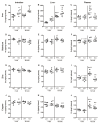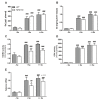Crosstalk of Nrf2 with the Trace Elements Selenium, Iron, Zinc, and Copper
- PMID: 31491970
- PMCID: PMC6770424
- DOI: 10.3390/nu11092112
Crosstalk of Nrf2 with the Trace Elements Selenium, Iron, Zinc, and Copper
Abstract
Trace elements, like Cu, Zn, Fe, or Se, are important for the proper functioning of antioxidant enzymes. However, in excessive amounts, they can also act as pro-oxidants. Accordingly, trace elements influence redox-modulated signaling pathways, such as the Nrf2 pathway. Vice versa, Nrf2 target genes belong to the group of transport and metal binding proteins. In order to investigate whether Nrf2 directly regulates the systemic trace element status, we used mice to study the effect of a constitutive, whole-body Nrf2 knockout on the systemic status of Cu, Zn, Fe, and Se. As the loss of selenoproteins under Se-deprived conditions has been described to further enhance Nrf2 activity, we additionally analyzed the combination of Nrf2 knockout with feeding diets that provide either suboptimal, adequate, or supplemented amounts of Se. Experiments revealed that the Nrf2 knockout partially affected the trace element concentrations of Cu, Zn, Fe, or Se in the intestine, liver, and/or plasma. However, aside from Fe, the other three trace elements were only marginally modulated in an Nrf2-dependent manner. Selenium deficiency mainly resulted in increased plasma Zn levels. One putative mediator could be the metal regulatory transcription factor 1, which was up-regulated with an increasing Se supply and downregulated in Se-supplemented Nrf2 knockout mice.
Keywords: Nrf2; copper; homeostasis; iron; selenium; zinc.
Conflict of interest statement
The authors declare no conflict of interest.
Figures





Similar articles
-
Plasma manganese, selenium, zinc, copper, and iron concentrations in patients with schizophrenia.Biol Trace Elem Res. 2004 May;98(2):109-17. doi: 10.1385/BTER:98:2:109. Biol Trace Elem Res. 2004. PMID: 15073409
-
Acute and subacute response of iron, zinc, copper and selenium in pigs experimentally infected with Actinobacillus pleuropneumoniae.Metallomics. 2014 Oct;6(10):1869-79. doi: 10.1039/c4mt00148f. Epub 2014 Aug 6. Metallomics. 2014. PMID: 25100437
-
Essential trace elements selenium, zinc, copper, and iron concentrations and their related acute-phase proteins in patients with vivax malaria.Biol Trace Elem Res. 2005 Aug;106(2):107-15. doi: 10.1385/BTER:106:2:107. Biol Trace Elem Res. 2005. PMID: 16116242
-
Interactions of iron with manganese, zinc, chromium, and selenium as related to prophylaxis and treatment of iron deficiency.J Trace Elem Med Biol. 2017 May;41:41-53. doi: 10.1016/j.jtemb.2017.02.005. Epub 2017 Feb 12. J Trace Elem Med Biol. 2017. PMID: 28347462 Review.
-
[Analyses of the relationship between the concentrations of essential trace elements in total mixed ration and faeces samples from Holstein Friesian dairy cows and the estimation of faeces reference values].Schweiz Arch Tierheilkd. 2022 Oct;164(10):709-719. doi: 10.17236/sat00370. Schweiz Arch Tierheilkd. 2022. PMID: 36193781 Review. German.
Cited by
-
Hydroxy-Selenomethionine Mitigated Chronic Heat Stress-Induced Porcine Splenic Damage via Activation of Nrf2/Keap1 Signal and Suppression of NFκb and STAT Signal.Int J Mol Sci. 2023 Mar 30;24(7):6461. doi: 10.3390/ijms24076461. Int J Mol Sci. 2023. PMID: 37047433 Free PMC article.
-
Association of dietary total antioxidant capacity with all-cause and cardiovascular mortality in patients with chronic kidney disease: based on two retrospective cohort studies of NHANES.Ren Fail. 2023 Dec;45(1):2205950. doi: 10.1080/0886022X.2023.2205950. Ren Fail. 2023. PMID: 37259554 Free PMC article.
-
Identification of Food-Derived Electrophilic Chalcones as Nrf2 Activators Using Comprehensive Virtual Screening Techniques.Antioxidants (Basel). 2025 Apr 30;14(5):546. doi: 10.3390/antiox14050546. Antioxidants (Basel). 2025. PMID: 40427428 Free PMC article.
-
Dietary Trace Minerals.Nutrients. 2019 Nov 19;11(11):2823. doi: 10.3390/nu11112823. Nutrients. 2019. PMID: 31752257 Free PMC article.
-
Cellular Redox Homeostasis.Antioxidants (Basel). 2021 Aug 28;10(9):1377. doi: 10.3390/antiox10091377. Antioxidants (Basel). 2021. PMID: 34573009 Free PMC article.
References
-
- Tebay L.E., Robertson H., Durant S.T., Vitale S.R., Penning T.M., Dinkova-Kostova A.T., Hayes J.D. Mechanisms of activation of the transcription factor Nrf2 by redox stressors, nutrient cues, and energy status and the pathways through which it attenuates degenerative disease. Free. Radic. Biol. Med. 2015;88:108–146. doi: 10.1016/j.freeradbiomed.2015.06.021. - DOI - PMC - PubMed
MeSH terms
Substances
Grants and funding
LinkOut - more resources
Full Text Sources
Medical
Research Materials

